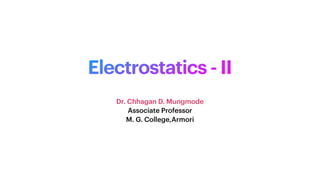Gauss's Law & its Applications
- 1. Electrostatics - II Dr. Chhagan D. Mungmode Associate Professor M. G. College,Armori
- 2. GaussŌĆÖs Law: The total electric f lux passing normally through a closed surface of any shape in an electric f ield is equal to time the total charge present within the surface. If there is no charge present within the surface or charges lies outside the surface, then Gaussian Surface: The Gaussian surface is an imaginary closed surface in three-dimensional space draw around the distribution of charges so that the f lux of electric f ield is calculated. Gaussian surface for a point charge and charged sphere is a sphere. 1 ŽĄ0 ŽĢ = Ōł¼ E Ōŗģ da = 1 ŽĄ0 ╬Ż q ŽĢ = Ōł¼ E Ōŗģ da = 0
- 3. Application of GaussŌĆÖs Law: 1. The electric f ield intensity due to point charge by Gauss's Law: Let us consider, a source point charge particle of +q coulomb is placed at point O in space. Let take a point P on the electric f ield of source point charge particle. To f ind the electric f ield intensity at point P, f irst put the test charge particle on the point P and draw a gaussian surface which passes through the point P. After that take a very small area around the point P. If the distance between the source charge particle and small area is r then electric f lux passing through the small area from the f igure, the direction between and is parallel to each other i.e. the angle will be 0. So the above equation can be written as E +q0 dA dA dŽĢ = E Ōŗģ dA = EdA cos ╬Ė E dA dŽĢ = EdA cos 0 = EdA
- 4. The electric f lux passing through the entire Gaussian surface and be f ind by closed integration of above equation According to Gauss's Law then above equation can be written as The above expression is the electric f ield intensity due to point source charged particle. ŽĢ = Ōł« EdA = E Ōł« dA ŽĢ = q ╬Ą0 ŽĢ = q ╬Ą0 = E 4ŽĆr2
- 5. Electric Field Intensity due to uniformly charged spherical shell: Consider a uniformly charged spherical shell of radius R and charge on it +q. 1. Point outside the spherical shell: Consider a point P outside the shell at a distance r from the centre O of the sphere. Draw a Gaussian sphere of radius r enclosing the spherical shell so that point P lie on the surface of the Gaussian sphere.
- 6. Hence it is clear that electric intensity at any point outside the spherical shell is such, as if the entire charge is concentrated at the centre of the shell. 2. Field at the surface of the shell- ŌĆ© For this we have r = R ŌĆ© If is the charge density on the shell, then ŌĆ© 3. Field inside the shell - ŌĆ© If the point P lies inside the spherical shell, then Gaussian surface is a surface of sphere of radius r ŌĆ© As there is no charge inside the spherical shell, Gaussian surface encloses no charge. ŌĆ© That is q=0 ŌĆ© Hence the field inside the spherical shell is always zero. ŌĆ© E = 0 ŌĆ© Hence the field inside the spherical shell is always zero.







